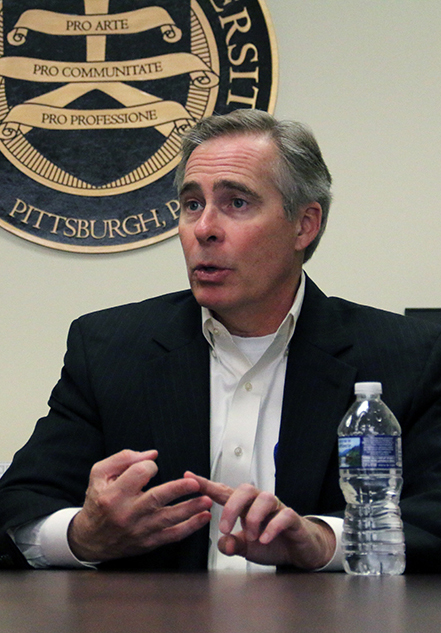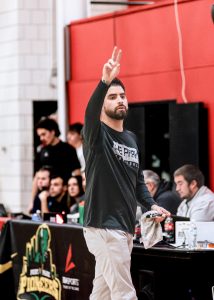Hennigan: increased student need drives annual tuition hikes
Photo by Nikole Kost
Point Park University President Paul Hennigan
April 18, 2017
Tuition set earlier this year for the 2017-2018 school year will increase for all students by 3.9 percent due mostly to an increased need for student financial aid, according to President Paul Hennigan.
“We have been cutting expenditures here at the university for seven years now in an effort to try and reduce the revenue increase necessary to pass on in the form of a tuition increase to our students,” Hennigan said in an interview March 22. “So when we announce a 3.9 percent tuition increase, roughly half of that, and I’m not kidding, goes straight to financial aid.”
In his role as university president, Hennigan proposes the increase on a yearly basis in the form of a budget to the board of trustees, who approves tuition rates.
The finance group working under the president’s office puts together the budget based on a number of factors, primarily enrollment.
“In the case of the university, the revenue that we receive is 93 percent dependent on enrollment,” Hennigan said. “It’s basically tuition and fees, room and board. Those four categories make up the revenue budget. That is very common for schools in our sector of the market.”
Hennigan defines Point Park’s “sector of the market” as small, private colleges and universities in the greater Pittsburgh area. He likened the university’s budget to a larger-scale version of a home budget where tuition is the primary source of income whereas financial aid and personnel are the primary expenditures.
“The amount of scholarships that we give to students is the single largest expenditure increase by far – beyond anything else: salaries, personnel, operations,” Hennigan said. “We know, or we have a good educated guess, how much money we have to award in scholarships to make it work for you to come to school.”
Hennigan then listed other contributing factors to the gap between expenditures and revenues.
“We have personnel costs, health care costs that go up every single year, utility costs that go up every single year, so we try to estimate all of those costs and after we have estimated what we think our enrollment revenue numbers are and what we think our expenditure numbers are, we compare the two,” Hennigan said.
The difference, after cutting expenditures where possible, is then passed on to students in the form of tuition increases.
Tuition for the 2015-2016 school year was a 4.9 percent increase for students in the Conservatory of Performing Arts and a 3.9 percent increase for non-Conservatory students.
Tuition for the 2016-2017 school year was a 2.9 percent increase from the preceding year – the lowest increase in recent years.
The numbers are calculated based on the difference between those enrollment estimates and the existing need for financial aid.
If both tuition and the need for financial aid increase annually, how can an institution expect to balance a budget in this way?
“That’s how it works,” Hennigan said. “That is how the private sector of higher education in America prices tuition. I’m not saying it’s right, I’m not making any judgment on it, but I’m saying that’s how the entire private sector of higher education prices tuition.”
Financial aid given by the university is broken down into two categories: merit and need-based scholarships.
“For most students, it’s balancing out because what one student might get in a presidential scholarship, another student is probably going to get in a need scholarship and all of that information by law is confidential, so I can’t go into details about how scholarshipping works for individual students,” Hennigan said.
The university offers five scholarships for incoming freshmen only in the schools of arts and sciences, business and communication. Those annual scholarships are the Presidential ($18,000), Vice Presidential ($16,000), Trustee ($14,000), Founders ($13,000) and the Point Park Opportunity Grant ($11,000). Each award is based upon the awardee’s GPA, SAT and ACT scores and must “meet University’s standard academic progress policy to keep the award.”
Point Park offers three scholarships for students in the Conservatory of Performing Arts: the Artistic Achievement (ranging from $3,000-$25,000 annually), Dean’s Academic Freshmen ($5,000) and Dean’s Academic Transfer ($5,000). These awards are based upon GPA, SAT and ACT scores and must demonstrate a “high caliber of artistic ability” within their artistic audition process or interview.
“Surprisingly, it all kind of balances out in the end because your circumstances are going to be different than his circumstances, and your merit scholarships might be different but your need usually balances it out,” Hennigan said.
Calling financial aid the “biggest expenditure driver,” Hennigan explained the economy has an impact on students’ need.
“Amazingly, the average income of the middle class has not increased significantly; we see more need every year,” Hennigan said. “Need goes up every year. So when you read about economics in the newspaper and you read that the middle class is getting squeezed out, we see it with students coming in the door. Students are needier, at least our students are.”
Hennigan said the university has explored offering a “locked in” tuition rate where a student would pay one flat tuition rate for their four years at Point Park. He said that in order to do so, the percent increase for that initial year would be too high to justify it, guessing that it would increase somewhere between 16 and 18 percent.
Lou Corsaro, managing director of university marketing and public relations, said in the same Mar. 22 interview that expenditures for the university do not include larger capital projects such as the new Pittsburgh Playhouse and Center for Media Innovation (CMI).
“Another thing that needs to be clear to some students is that they seem to think when they see the CMI goes up, is that it’s something they paid for. And they didn’t,” Corsaro said. “We received a generous grant for that. These aren’t things that are costing students money. They don’t go on the tuition. The playhouse is not a factor in that.”
Hennigan said that there are no plans for larger capital projects and the existing projects do not impact the price of tuition.
“Not one dime of tuition money [was spent] in the [Village] park,” Hennigan said. “It was all grant-funded. We wouldn’t do that.”
Hennigan said that while the national average of an undergraduate student loan in the U.S. is $24,000, and the average undergraduate loan at Point Park is $16,000.
It should be noted that without access to individuals’ accounts, this figure cannot be confirmed.
“The value of a college degree is indisputable,” Hennigan said. “With that in mind, I would encourage every student to take full advantage of every opportunity available at Point Park and through Point Park and through the collegiate experience. As far as costs go, the way to feel good about paying an increase in cost is to know that you’re getting the value that you want.”



















